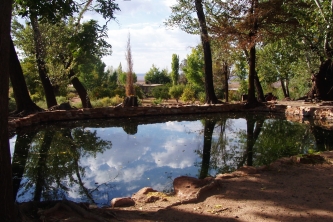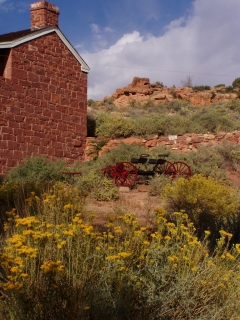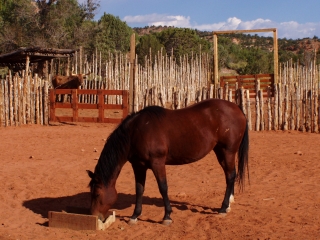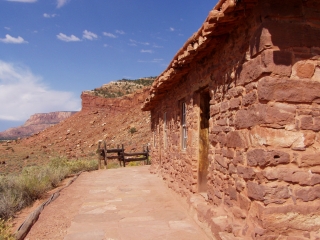NPS Website; Local Website
 WHAT IS IT?
WHAT IS IT?A natural water source in the desolate Arizona Strip, the portion of the Colorado Plateau between the Grand Canyon and the Vermillion Cliffs.
BEAUTY (6/10)
The grounds of Pipe Spring NM are a peaceful oasis that allow for remarkable views of surrounding pinkish orange mesas, cliffs and buttes. The red sandstone buildings, the Winsor Castle and the East and West Cabins, blend in nicely with their natural surroundings. The most unexpectedly charming part of the Site was the holding ponds, stocked with ducks. In the northern Arizona wasteland, no less!
HISTORICAL INTEREST (6/10)
Water attracts life even in a place as remote and as dry as Pipe Spring. The spring has been known for over 10,000 years and the lands around it were settled for at least 2000 years. The history explained on Site is mostly local, Mormon and Paiute, their relations and the many ways they used the water to thrive. The history taught ranges from the mundane: food sources, crop cultivation, telegraph lines and gathering techniques to the salacious: second and third wives hiding from polygamy marshals, Ute and Navajo slaving raids and Mormon-led massacres.
The Monument was created in 1923, partially because of the local history but mostly because the Park Service wanted a “cool oasis and potential lunch spot” for tourists traveling from Zion NP to the North Rim of the Grand Canyon. We are thankful because both the museum and the Ranger tours do such a terrific job in instruction that what seemed at first to be a site of dubious historical importance came alive. Pipe Spring was a rich historical respite from the area’s scenic wonders and an illuminating answer to how people lived on the Colorado Plateau.
 CROWDS (8/10)
CROWDS (8/10)There were not a lot of people at Pipe Spring NM, but everyone there was just as excited as we were to have stumbled onto on of the National Park System’s true gems. All 12 of the people on our guided tour of Winsor Castle asked probing smart questions. We just sat back and listened; the other peoples’ questions led the discussion into fascinating territory ranging from transcendental cosmic travel methods to the nutritious value of piñon nuts.
EASE OF USE/ACCESS (2/5)
Pipe Spring NM no longer lies on the road between Zion NP and the Grand Canyon’s North Rim. The Zion-Mt. Carmel Tunnel, completed in 1930, ended that as traffic now goes straight down U.S. Route 89 through Fredonia and down to the North Rim. Tourism has never completely recovered from the early 1920’s boom.
That is a shame, especially since Pipe Spring is only a 30-mile round trip detour from Fredonia. Pipe Spring NM is also about 40 miles east of Interstate 15 and St. George, Utah.
CONCESSIONS/BOOKSTORE (5/5)
The bookstore at Pipe Spring, although half the size and flash of it’s neighbor at Zion NP, rivaled it in the quality and selection and of items offered. Books lined the shelves along with sand paintings, jewelry and other crafts that varied in size, quality and price. If you want a small inexpensive gift, you can find it here. If you want a quality handcrafted item to remind you of your trip out West, they are here too.
What they don’t have, unfortunately, are batteries for your camera. Our rechargeable batteries ran out of juice before we finished touring the grounds. In a gesture above and beyond her call of duty, the bookstore clerk pointed to a hidden outlet behind a shelf and let us plug in and charge up while we browsed the store.
You know a bookstore is good if we actually pull out our wallets (a rare occurrence!) Michael picked up a Wallace Stenger book on John Wesley Powell; Gab purchased a necklace made of tiny beads and seeds.
COSTS (4/5)
Entry is $4 per person, those 16 and under are admitted free. There is no charge if you have the National Parks Pass. If you come at midday, there might even be free vegetable stew.
RANGER/GUIDE TO TOURIST RATIO (5/5)
The handful of people that traveled to Pipe Spring were met by one effervescent Ranger, a wisdom spitting guru of a Ranger and an exceedingly knowledgeable free-speaking volunteer. We could not ask for more. All three engaged us in conversation for at least twenty minutes apiece. Great people, great teachers.
 TOURS/CLASSES (10/10)
TOURS/CLASSES (10/10)Pipe Spring NM had three learning stations, all superior in their own way: a local history museum, a guided tour of Winsor Castle and a Ranger posted at a chuck wagon.
Our tour of Winsor Castle started a few minutes late since the guide was still answering questions and speaking with participants from the previous tour. We soon understood why they were so reluctant to leave his company. Our guide was not a Ranger. He was one of those rare volunteers that is incredibly well-read on the topic he is presenting, knows when to insert humor and his own reflections into a tour and when to allow visitors to make their own connections with the setting and situation and come to their own conclusions. He was friendly and thoughtful and he made Pipe Spring come to life for us. Thank you, John.
As we were exiting the Castle, we all noticed something that wasn’t there when we entered – the scent of a fire and something cooking by the chuck wagon. We, along with the other folks in our tour, all tried to act casual as we sauntered over to the man dressed in period clothes cutting potatoes and prepping a Dutch oven.
“So…what are you cooking?” (as in, when will it be ready and can we have some?)”Potatoes,” he said, stating the obvious and looking at us like we were idiots.
He then went on to talk about a number of things. This is where the transcendental cosmic travel methods and the nutritious value of piñon nuts conversation occurred. We’re not quite sure how that conversation started, but we stayed to listen to the whole thing. We’d tried to explain it if we could.
The small museum was actually one of our final stops at Pipe Spring. It was quiet and unassuming, filled with pictures and explanations of the Paiutes and their culture alongside the later inhabitants of Pipe Spring, the Mormon settlers.
Pipe Spring was a tithing farm for the Mormons, the place where they kept all of the cattle and livestock donated to the church. There are pictures and artifacts of the families who managed the farm and lived in Winsor Castle. Gab’s favorite part of the museum was a corner full of handmade photo albums and oral histories of Mormon families who lived in the Arizona strip in the 19th and early 20th century, detailing their daily lives with diary accounts, stories retold from grandparents, pictures and drawings. Some albums were in memory of people who had passed away. Other photocopied collections were still maintained by local families. It is rare that museums get this personal. This was a nice touch.
 FUN (8/10)
FUN (8/10)As we were walking back out to the gardens and spring, we ran into our guide from the morning’s tour. “Did you kids get lost? The highway’s in the other direction!” He was amazed that we were still there. So were we! We then stood and chatted at length with the older gentleman about several of the other parks we have or plan to visit. Turns out he is also a volunteer at the Golden Spike NHS. So then we started talking about railroads.
This is how our day at Pipe Spring progressed. Conversations kept springing into more interesting and diverse topics. How often does that happen? We felt as if we had opened a treasure box with each person we spoke with – visitors, rangers, volunteers. Everyone. Where are we? Perhaps we were just longing for some social history and learning after spending so much time contemplating nature. Pipe Spring hit the spot.
WOULD WE RECOMMEND? (8/10)
We came to the Site without any knowledge of the Arizona Strip. We dreaded our visit and did not expect to spend more than a half hour at Pipe Spring. Three hours later we left, fascinated by what we had learned, appreciative of the wonderful educational tactics and thankful to have encountered intelligent, idea-challenging Rangers.
If you go to Zion NP, also come to Pipe Spring NM. The historical undercurrents of Zion, Bryce Canyon and the entire area’s 19th Century settlement are addressed here without judgment as to who was in the right. The southwest National Parks do not talk about their human past. They tell you 1) appreciate the beautiful scenery (not a bad thing) 2) Indians lived here 10,000 years ago and 3) figure the rest out on your own. Pipe Spring NM fills in the blanks.
TOTAL 62/80
www.usa-c2c.com
© 2004-06